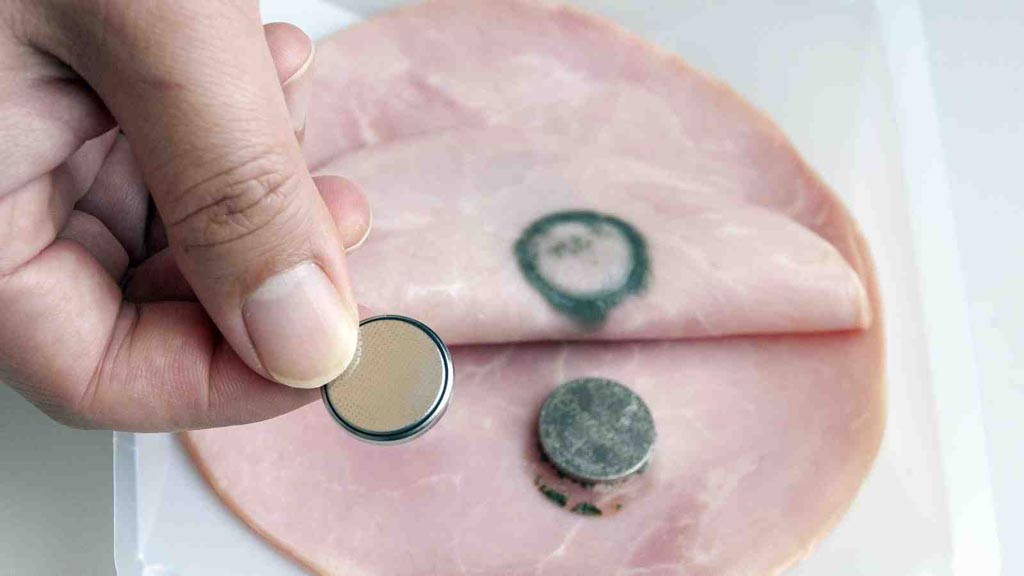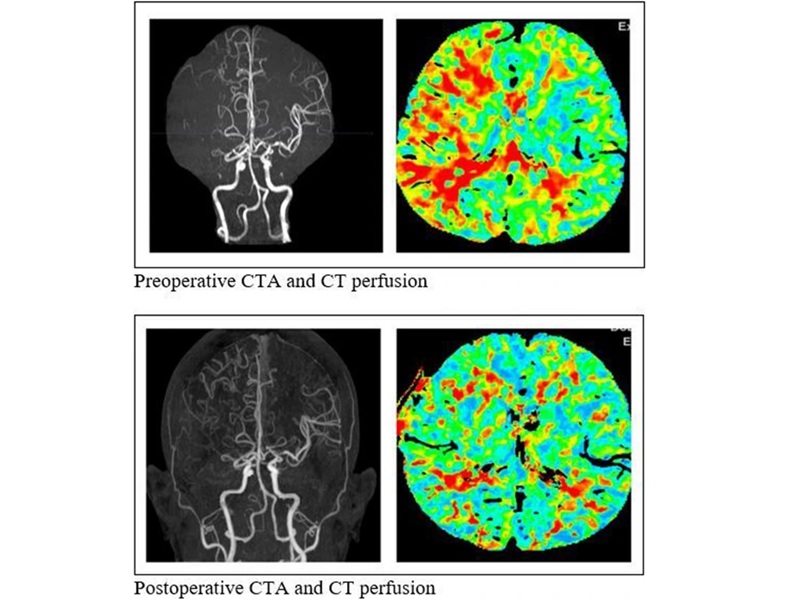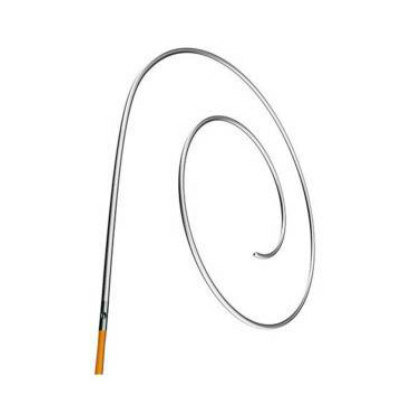Novel Compound Detects Ingested Button Batteries
|
By HospiMedica International staff writers Posted on 29 Apr 2019 |

Image: New research shows that battery buttons can cause severe damage to tissues when swallowed (Photo courtesy of VUW).
A novel coating made of nontoxic alkaloids and bitter tasting compound triggers a pungent taste that causes infants to expel a button battery rather than swallow it.
Developed at Victoria University of Wellington (VUW; New Zealand), the battery coating dissolves when coming in contact with saliva, turning it blue, thus alerting parents or caregivers that a child has ingested a battery. At the same time, bitter flavorings in the coating dissuade ingestion and an emetic compound triggers vomiting, which may lead to expulsion of the battery, or at least alert the caregivers to the issue. The compound can also be incorporated into an applicator that can be used to mark unprotected batteries and other small objects with a choking risk.
“The problem is that parents don't always know that ingestion has occurred, because the batteries are so small and young children can't communicate that they have swallowed something,” said technology developer Jeongbin Ok, MID, of the VUW School of Design. “It has always been my dream to help save lives. I hope this coating can play a part in doing so by creating an invention that has global implications for the safety of children. I hope to see mass production of this coating and to see it become an industry standard.”
“This is a very exciting innovation and a great example of Kiwi ingenuity addressing a very real and serious hazard in a practical and cost-effective way,” said Martin Rushton, of the New Zealand Ministry of Business, Innovation, and Employment (MBIE). “This 'early warning' system will complement other measures around warnings and education, and we are encouraging battery manufacturers get behind improving consumer safety. Parents and caregivers will, I am sure, be keen to see button batteries with this feature, to help safeguard infants and young children.”
Button batteries are highly corrosive and can cause serious tissue damage and even fatalities within two hours of ingestion. The swallowed battery typically gets lodged in the esophagus, where it reacts with body fluids, completing a circuit, which results in the production of toxic hydroxide. The local build-up of this caustic chemical can cause tissue necrosis, throat damage, and even death. Battery ingestion causes around 3,000 annual hospitalizations in the United States alone.
Related Links:
Victoria University of Wellington
Developed at Victoria University of Wellington (VUW; New Zealand), the battery coating dissolves when coming in contact with saliva, turning it blue, thus alerting parents or caregivers that a child has ingested a battery. At the same time, bitter flavorings in the coating dissuade ingestion and an emetic compound triggers vomiting, which may lead to expulsion of the battery, or at least alert the caregivers to the issue. The compound can also be incorporated into an applicator that can be used to mark unprotected batteries and other small objects with a choking risk.
“The problem is that parents don't always know that ingestion has occurred, because the batteries are so small and young children can't communicate that they have swallowed something,” said technology developer Jeongbin Ok, MID, of the VUW School of Design. “It has always been my dream to help save lives. I hope this coating can play a part in doing so by creating an invention that has global implications for the safety of children. I hope to see mass production of this coating and to see it become an industry standard.”
“This is a very exciting innovation and a great example of Kiwi ingenuity addressing a very real and serious hazard in a practical and cost-effective way,” said Martin Rushton, of the New Zealand Ministry of Business, Innovation, and Employment (MBIE). “This 'early warning' system will complement other measures around warnings and education, and we are encouraging battery manufacturers get behind improving consumer safety. Parents and caregivers will, I am sure, be keen to see button batteries with this feature, to help safeguard infants and young children.”
Button batteries are highly corrosive and can cause serious tissue damage and even fatalities within two hours of ingestion. The swallowed battery typically gets lodged in the esophagus, where it reacts with body fluids, completing a circuit, which results in the production of toxic hydroxide. The local build-up of this caustic chemical can cause tissue necrosis, throat damage, and even death. Battery ingestion causes around 3,000 annual hospitalizations in the United States alone.
Related Links:
Victoria University of Wellington
Latest Critical Care News
- Remote Ventilate View Platform Enables Real-Time Monitoring of Patient-Ventilator Asynchrony
- Soft “Cyborg” Cardiac Patches Improve Stem Cell Heart Repair
- Soft Wearable System Offers Continuous Wireless Monitoring of Neonatal Health
- AI-Enhanced Wearables Could Transform Type 2 Diabetes and Prediabetes Care
- Breathable Electronic Skin Paves Way for Next-Generation Wearable Devices
- AI Transforming Colon Cancer Diagnosis
- Ventricular Assist Device Offers Long-Term Use in Children Waiting for Donor Heart
- Precision Approach Improves Immunotherapy Effectiveness for ICU Patients with Sepsis
- Soft Robots Could Donate Their Heart to Humans
- Bioadhesive Strategy Prevents Fibrosis Around Device Implants on Peripheral Nerves
- Miniature Non-Invasive Robotic Catheters to Improve Infertility Treatments
- Stick-On Patch Monitors Baby's Movements In Utero
- EEG-Based AI Technology Accurately Diagnoses Alzheimer’s and Dementia
- Robot Lymphatic System Paves Way for Self-Powered Wearables and Machines
- Focused Ultrasound Technique Successfully Treats Pediatric Brain Cancer
- Nasal Drops Fight Brain Tumors Noninvasively
Channels
Surgical Techniques
view channel
Simple Bypass Protocol Improves Outcomes in Chronic Cerebral Occlusion
Chronic cerebral arterial occlusion and moyamoya disease are major causes of ischemic stroke, particularly in regions where access to advanced diagnostic tools is limited. Assessing cerebral blood flow... Read more
Implantable Absorbable Sensor Detects Life-Threatening Complications After Intestinal Surgery
Intestinal anastomoses are among the riskiest procedures in abdominal surgery, with complications such as circulatory disorders or immune reactions often developing rapidly and unpredictably.... Read morePatient Care
view channel
Revolutionary Automatic IV-Line Flushing Device to Enhance Infusion Care
More than 80% of in-hospital patients receive intravenous (IV) therapy. Every dose of IV medicine delivered in a small volume (<250 mL) infusion bag should be followed by subsequent flushing to ensure... Read more
VR Training Tool Combats Contamination of Portable Medical Equipment
Healthcare-associated infections (HAIs) impact one in every 31 patients, cause nearly 100,000 deaths each year, and cost USD 28.4 billion in direct medical expenses. Notably, up to 75% of these infections... Read more
Portable Biosensor Platform to Reduce Hospital-Acquired Infections
Approximately 4 million patients in the European Union acquire healthcare-associated infections (HAIs) or nosocomial infections each year, with around 37,000 deaths directly resulting from these infections,... Read moreFirst-Of-Its-Kind Portable Germicidal Light Technology Disinfects High-Touch Clinical Surfaces in Seconds
Reducing healthcare-acquired infections (HAIs) remains a pressing issue within global healthcare systems. In the United States alone, 1.7 million patients contract HAIs annually, leading to approximately... Read moreHealth IT
view channel
EMR-Based Tool Predicts Graft Failure After Kidney Transplant
Kidney transplantation offers patients with end-stage kidney disease longer survival and better quality of life than dialysis, yet graft failure remains a major challenge. Although a successful transplant... Read more
Printable Molecule-Selective Nanoparticles Enable Mass Production of Wearable Biosensors
The future of medicine is likely to focus on the personalization of healthcare—understanding exactly what an individual requires and delivering the appropriate combination of nutrients, metabolites, and... Read moreBusiness
view channel
Philips and Masimo Partner to Advance Patient Monitoring Measurement Technologies
Royal Philips (Amsterdam, Netherlands) and Masimo (Irvine, California, USA) have renewed their multi-year strategic collaboration, combining Philips’ expertise in patient monitoring with Masimo’s noninvasive... Read more
B. Braun Acquires Digital Microsurgery Company True Digital Surgery
The high-end microsurgery market in neurosurgery, spine, and ENT is undergoing a significant transformation. Traditional analog microscopes are giving way to digital exoscopes, which provide improved visualization,... Read more
CMEF 2025 to Promote Holistic and High-Quality Development of Medical and Health Industry
The 92nd China International Medical Equipment Fair (CMEF 2025) Autumn Exhibition is scheduled to be held from September 26 to 29 at the China Import and Export Fair Complex (Canton Fair Complex) in Guangzhou.... Read more















